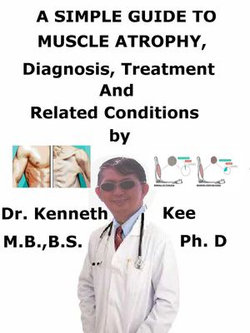This book describes Muscle Atrophy, Diagnosis and Treatment and Related Diseases
Muscle atrophy is the loss or wasting (thinning) of the muscle tissue.
If the patient has atrophied muscles, the patient will notice a decrease in the muscle mass and strength.
With muscle atrophy, the muscles appear smaller than normal.
Muscle atrophy may be caused by age, lack of use, or disease.
It can involve people at any age, including infants and the elderly.
Muscle atrophy can also happen in one part of the body while sparing other parts.
Muscle atrophy can happen due to malnutrition, age, genetics, muscle injury, reduced muscle activity, lack of physical activity or certain medical disorders.
1.Disuse or physiologic atrophy happens when the patient does not use the muscles enough.
The lack of physical activity for long period gives rise to muscle inactivity.
As a result, person is not able to do muscular movements, faces difficulty in muscle coordination, and loses muscle strength.
2.Neurogenic atrophy happens due to nerve problems or nerve diseases.
3.Pathologic atrophy happens due to aging, starvation, and medical disorders
Unused muscles can waste away if the person does not actively move the muscles.
This type of atrophy can often be reversed with exercise and improved nutrition.
Muscle atrophy can also result if the person is bedridden or unable to move certain body parts
Astronauts can develop muscle atrophy after a few days of weightlessness.
Other causes for muscle atrophy are:
Lack of physical activity for a prolonged period of time
Aging
Alcohol-linked myopathy
Burns
Injuries, such as a torn rotator cuff or broken bones
Malnutrition
Spinal cord or peripheral nerve injuries
Stroke
Long-term corticosteroid therapy
1.Neurological disorders are linked with neurogenic muscle atrophy.
The nerves of a muscle become damaged due to an injury.
Consequently, the transfer of signals from nerves to the brain does not happen.
Without signaling pathways, muscles do not contract.
The loss of muscle contraction will lead to the loss of muscle activity.
Neurogenic muscle atrophy is the major cause of muscle atrophy.
2.Age
With the increase in age, the muscle mass began to diminish due to the decline in the production of muscle protein.
The constant decrease in muscle protein produces muscle wasting.
3.Nutritional Deficiency
When there is any deficiency of proteins, carbohydrates, vitamins, and minerals in the body intakes, it leads to malnutrition.
The nutritional deficiency is also accountable for muscle atrophy or muscle wasting.
All metabolic disorders are linked with weight loss and muscle mass loss.
4.Genetics
There are researches that indicated the cause of muscle atrophy is a kind of genetic disorder.
Mutation of the genes that code for muscle protein leads to the decrease of protein.
That results in muscle weakness and muscle atrophy.
5.Medical Disorders
Spinal cord atrophy,
Multiple sclerosis
Amyotrophic lateral sclerosis
Guillain-Barre syndrome
Diabetic neuropathy
Diagnosis is by
Blood test.
Muscle or nerve biopsy.
Electromyography (EMG)
Nerve conduction studies.
X-rays.
Computed tomography (CT) scan
Magnetic resonance imaging (MRI) scan
PET scan
Frequent treatments for muscle atrophy are:
Medications
Physical Therapy
Ultrasound Therapy
Use of Accessories (Wheelchair, Braces, etc.)
Surgery
Dietary changes and supplement
TABLE OF CONTENT
Introduction
Chapter 1 Muscle Atrophy
Chapter 2 Cause
Chapter 3 Symptom
Chapter 4 Diagnosis
Chapter 5 Treatment
Chapter 6 Prognosis
Chapter 7 Sarcopenia
Chapter 8 Malnutrition
Epilogue



Share This eBook: